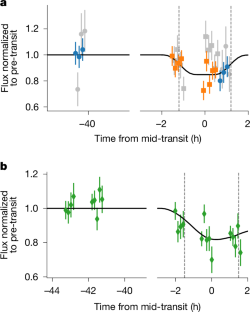氢从一对比海王星小的系外行星中逃逸
IF 48.5
1区 综合性期刊
Q1 MULTIDISCIPLINARY SCIENCES
引用次数: 0
摘要
系外行星调查显示,在近100天的轨道上有大量比海王星小的系外行星1,2,3,4。这些行星形成了两个种群,在约1.8 R⊕的地方被称为半径谷,被自然分隔开。目前尚不确定这些种群是来自不同的干燥与富水形成渠道,还是由于长期的大气损失而形成的,或者是由于这两种因素的结合而形成的。在这里,我们报告了对两颗兄弟行星TOI-776 b(1.85±0.13 R⊕)和TOI-776 c(2.02±0.14 R⊕)的持续氢损失的观测,它们的大小接近半径谷,年龄成熟(1-4 Gyr),这对于研究它们所属的分裂星系群的起源很有价值。在这些行星的凌日过程中,吸收出现在宿主恒星的莱曼α发射上,与氢逃逸相容,其速率分别相当于每颗行星每十亿年总质量的0.03-0.6%和0.1-0.9%。外行星TOI-776 c的观测结果与分离蒸汽的流出不相容,这表明它和它的内部兄弟都是在干燥的环境中形成的。这些观测结果支持了氢损失在近轨道亚海王星演化中的重要作用5,6,7,8,15,16。本文章由计算机程序翻译,如有差异,请以英文原文为准。


Hydrogen escaping from a pair of exoplanets smaller than Neptune
Exoplanet surveys have shown a class of abundant exoplanets smaller than Neptune on close, <100-day orbits1–4. These planets form two populations separated by a natural division at about 1.8 R⊕ termed the radius valley. It is uncertain whether these populations arose from separate dry versus water-rich formation channels, evolved apart because of long-term atmospheric loss or a combination of both5–14. Here we report observations of ongoing hydrogen loss from two sibling planets, TOI-776 b (1.85 ± 0.13 R⊕) and TOI-776 c (2.02 ± 0.14 R⊕), the sizes of which near the radius valley and mature (1–4 Gyr) age make them valuable for investigating the origins of the divided population of which they are a part. During the transits of these planets, absorption appeared against the Lyman-α emission of the host star, compatible with hydrogen escape at rates equivalent to 0.03–0.6% and 0.1–0.9% of the total mass per billion years of each planet, respectively. Observations of the outer planet, TOI-776 c, are incompatible with an outflow of dissociated steam, suggesting both it and its inner sibling formed in a dry environment. These observations support the strong role of hydrogen loss in the evolution of close-orbiting sub-Neptunes5–8,15,16. Ongoing hydrogen loss from two sibling exoplanets provides support for the role of such hydrogen loss in the evolution of close-orbiting sub-Neptunes.
求助全文
通过发布文献求助,成功后即可免费获取论文全文。
去求助
来源期刊

Nature
综合性期刊-综合性期刊
CiteScore
90.00
自引率
1.20%
发文量
3652
审稿时长
3 months
期刊介绍:
Nature is a prestigious international journal that publishes peer-reviewed research in various scientific and technological fields. The selection of articles is based on criteria such as originality, importance, interdisciplinary relevance, timeliness, accessibility, elegance, and surprising conclusions. In addition to showcasing significant scientific advances, Nature delivers rapid, authoritative, insightful news, and interpretation of current and upcoming trends impacting science, scientists, and the broader public. The journal serves a dual purpose: firstly, to promptly share noteworthy scientific advances and foster discussions among scientists, and secondly, to ensure the swift dissemination of scientific results globally, emphasizing their significance for knowledge, culture, and daily life.
 求助内容:
求助内容: 应助结果提醒方式:
应助结果提醒方式:


